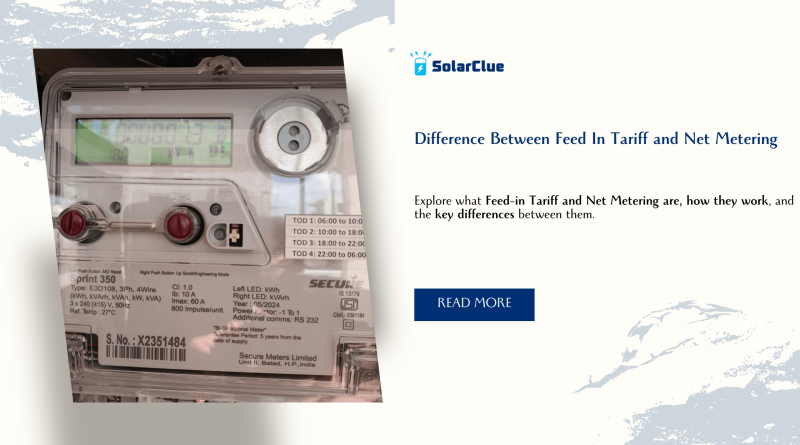Difference Between Feed In Tariff and Net Metering
As renewable energy continues to grow in popularity, two main mechanisms have been developed to encourage the adoption of solar power and other renewable sources: Feed-in Tariff (FiT) and Net Metering. Both of these mechanisms provide ways for consumers to benefit financially from generating their own electricity, but they operate in different ways. Understanding the differences between Feed-in Tariff and Net Metering can help you make an informed decision about which option is better suited to your needs.
In this blog, we’ll explore what Feed-in Tariff and Net Metering are, how they work, and the key differences between them.
Table of Contents
- 1 What is Feed-in Tariff (FiT)?
What is Feed-in Tariff (FiT)?
A Feed-in Tariff (FiT) is a policy designed to promote the generation of renewable energy by guaranteeing a fixed price for the electricity that consumers produce and export to the grid. Under this mechanism, the energy produced by the consumer (usually from solar panels, wind turbines, or other renewable sources) is sold to the utility company at a predetermined rate, typically for a long-term contract period (10-25 years).
How Feed-in Tariff Works:
- The consumer installs a renewable energy system (e.g., solar panels) and generates electricity.
- Any excess electricity generated is exported to the grid.
- The consumer receives a fixed payment for every kilowatt-hour (kWh) of electricity they export.
- Payments are usually higher than the market rate for electricity, incentivizing the production of renewable energy.
Advantages of Feed-in Tariff:
- Fixed Earnings: Consumers earn a fixed rate for the energy exported, offering predictable revenue over the contract period.
- Incentive to Maximize Production: Since the payments are guaranteed, consumers are encouraged to generate as much renewable energy as possible.
- Long-Term Contracts: FiT schemes often come with long-term contracts, providing stability for the investment in renewable energy systems.
What is Net Metering?
Net Metering is a billing mechanism that allows consumers to generate their own electricity and use it to offset their electricity bills. Under net metering, any excess electricity generated by a renewable energy system is exported to the grid, and the consumer receives credits that can be used to reduce future electricity bills. The consumer essentially “banks” the excess electricity and uses it later when their own system isn’t generating enough power (e.g., at night or during cloudy days).
How Net Metering Works:
- The consumer installs a renewable energy system (e.g., solar panels) to generate electricity.
- The electricity generated is used for self-consumption, and any excess energy is sent to the grid.
- The consumer receives credits for the energy exported, which are applied to future electricity bills.
- Net metering works on a “net” basis—i.e., the consumer only pays for the difference between the electricity imported from the grid and the electricity exported to the grid.
Advantages of Net Metering:
- Lower Electricity Bills: Consumers can significantly reduce their electricity bills by offsetting grid electricity with their own renewable energy.
- Energy Independence: Net metering allows consumers to become more self-sufficient by generating their own electricity.
- Simplicity: Net metering uses a simple billing mechanism, and consumers don’t need to negotiate separate contracts for selling energy.
Key Differences Between Feed-in Tariff and Net Metering
Though both Feed-in Tariff and Net Metering incentivize renewable energy production, they differ in several key aspects. Below is a table that highlights the main differences between the two mechanisms:
Comparison Between Feed-in Tariff (FiT) and Net Metering
| Aspect | Feed-in Tariff (FiT) | Net Metering |
|---|---|---|
| Basic Concept | Consumers are paid a fixed price for every kWh of energy exported to the grid. | Consumers earn credits for exporting excess energy to the grid and offset future bills. |
| Payment Type | Fixed payments for energy exported. | Energy credits applied against future electricity bills. |
| Rate of Payment | Usually higher than the market rate for electricity. | Typically the same rate as the retail electricity price. |
| Energy Usage | Energy generated is primarily sold to the grid. | Energy is used for self-consumption first, and excess is sent to the grid. |
| Contract Length | Long-term contracts, often 10-25 years. | No long-term contract; billing mechanism based on monthly/annual settlement. |
| Revenue Stability | Fixed income from selling electricity over the contract period. | Variable, depending on energy consumption and production patterns. |
| Primary Focus | Maximizing energy generation to sell to the grid. | Reducing electricity bills by using self-generated energy. |
| Billing System | Separate payment for electricity sold to the grid. | Credits are applied to reduce future electricity consumption bills. |
| Metering Requirement | Separate generation and consumption meters may be required. | A bi-directional (net) meter that tracks both import and export. |
| Best Suited For | Consumers looking to generate large amounts of electricity for profit. | Consumers aiming to reduce their electricity bills through self-consumption. |
| Maintenance of Energy Balance | All generated energy is exported, and the grid supplies energy when needed. | Self-generated energy is used first, then the grid supplements any shortfall. |
| Energy Purchase Agreements | Involves long-term purchase agreements with utility companies. | No purchase agreements required; simply a billing adjustment mechanism. |
| Energy Independence | Does not promote energy independence, as energy is sold to the grid. | Encourages energy independence by prioritizing self-consumption. |
| Regulatory Differences | Governed by specific Feed-in Tariff policies in each region/country. | Governed by state/provincial regulations for net metering. |
Key Points of Distinction
Financial Mechanism: Feed-in Tariff offers fixed payments for energy sold to the grid, while Net Metering provides credits for the excess energy exported to the grid, which can be used to offset future electricity bills.
Usage Focus: Feed-in Tariff incentivizes energy generation primarily for export, whereas Net Metering prioritizes self-consumption of generated energy, with excess sent to the grid.
Rate of Compensation: Feed-in Tariff usually offers higher-than-market rates for electricity exported, while Net Metering credits are generally provided at the retail electricity rate.
Long-Term Contracts vs. Flexibility: FiT often involves long-term contracts, ensuring predictable revenue, while Net Metering offers more flexibility without long-term commitments.
Which is Better: Feed-in Tariff or Net Metering?
The choice between Feed-in Tariff and Net Metering depends on your goals and energy usage patterns:
- If you are looking to generate large amounts of renewable energy and sell it to the grid for a profit, Feed-in Tariff may be the better option. It guarantees a fixed income and is ideal for large-scale solar farms or wind projects.
- If your goal is to reduce your electricity bills by generating your own renewable energy, Net Metering is likely more suitable. It allows you to offset your energy consumption and provides flexibility without long-term contracts.
Conclusion
Both Feed-in Tariff and Net Metering offer great benefits for consumers looking to adopt renewable energy. While Feed-in Tariff provides fixed payments for energy exported to the grid, Net Metering focuses on self-consumption and reducing electricity bills. By understanding the differences between the two, consumers can choose the option that best aligns with their energy needs and financial goals.
Ready to Save on Electricity Bills with Solar Power?
With Net Metering, you can drastically reduce your electricity costs by generating your own solar power and sending any excess back to the grid. It’s time to harness the sun’s energy and make a positive impact on both your wallet and the environment!
At SolarClue, we make the transition to solar simple, efficient, and affordable. Whether you’re a homeowner, business, or institution, our team of solar experts will guide you through the process—from installation to maintenance—so you can start saving from day one.
🌞 Take the first step towards energy independence today!
🔋 Get your solar consultation now!
Contact SolarClue or call us at +91-888-4444-830 to explore the best solar solutions for your home or business.
Go Solar. Save More. Power Your Future with SolarClue!
FAQs
1. What is the main difference between Feed-in Tariff and Net Metering?
Feed-in Tariff provides fixed payments for all electricity exported to the grid, whereas Net Metering allows consumers to offset their electricity bills using credits for excess energy generated.
2. Which option offers higher financial returns?
Feed-in Tariff generally offers higher returns because it provides fixed payments that are often above the retail electricity rate.
3. Can I switch from Feed-in Tariff to Net Metering?
Switching between the two mechanisms depends on local regulations and contracts with your electricity provider. Some regions may allow the transition, while others may not.
4. Is Net Metering available everywhere?
Net Metering policies vary by region, so it’s important to check with your local electricity provider or regulatory body.
5. What is the payback period for a solar system under Net Metering?
The payback period for a solar system under Net Metering typically ranges from 5 to 8 years, depending on the size of the system and electricity usage.




